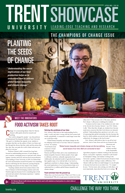 What do Mummies Eat?FOR IMMEDIATE RELEASE Trent University Anthropologist Reveals Lifestyle Clues of the Ancient Inca of Peru Tuesday, October 30, 2007, Peterborough
An ancient cemetery containing the remains of 500-year old mummies was discovered underneath the coastal town of Tupac Amaru, located near Lima, Peru. Due to the extreme dryness of this coastal desert, the people buried there were exceptionally well preserved and many still retained their skin, hair, fingernails, eyelashes, and even tattoos. Prof. Williams sampled different tissues from the mummies, such as bone, skin, hair, nail, tendon and muscle to test for chemical signatures left behind by the various foods consumed by these people. “Because bone develops very slowly, it records diets for the past 15 years, and hair, which grows at a rate of one centimetre per month, records diets in the weeks before death,” explained Prof. Williams. Health Clues By comparing the short- and long-term diets of these Inca remains, Prof. Williams was able to determine the types of foods that were eaten and how this impacted the overall health of the community. Based on carbon isotope data, she noted seasonal fluctuations in diet with corn consumed primarily in the summer and tubers (like potatoes) consumed primarily in the winter. This was somewhat surprising because the Inca were known for their ability to supply their populations with provisions from food stores, however this study demonstrated that people in this valley relied primarily on cultivated foods. These data enabled Prof. Williams to conclude that the overall health of this population was precarious since they did not have access to stored food in any quantity food, an important means of surviving crop failures. Her research also revealed that more people died in the summer than the winter. “This was unexpected because we usually see more deaths during the winter when conditions are harsher and there is greater chance of respiratory disease,” she said. “Through this research we were able to determine that there were fewer dietary choices during the summer which compromised nutrition and likely made this population more susceptible to summertime diseases.” Prof. Williams presented this paper in February 2007 as part of the sixth Mummy Congress that took place in Teguise, Canary Islands. -30- For further information, please contact Professor Jocelyn Williams at (705) 748-1011, ext. 7441 Photo credit: Guillermo Cock For additional photos related to Prof. Williams’ research, please contact Brittany Cadence, communications officer at (705) 748-1011, ext. 6185. |

































 Research undertaken by Trent University assistant anthropology professor Jocelyn Williams into the diets of recently unearthed mummies has revealed fascinating insights into the lives of the ancient Inca of Peru.
Research undertaken by Trent University assistant anthropology professor Jocelyn Williams into the diets of recently unearthed mummies has revealed fascinating insights into the lives of the ancient Inca of Peru.